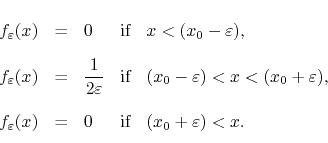Next: Reduction to the Identity Up: Appendix: Properties of the Previous: Continuity of Filtered Functions
Let us assume that we have the ``function''
![]() . Since
this is an integrable object, we may calculate the corresponding filtered
function, which as we shall see is in fact an actual function. The
function
. Since
this is an integrable object, we may calculate the corresponding filtered
function, which as we shall see is in fact an actual function. The
function
![]() that corresponds to
that corresponds to ![]() through the
first-order filter of range
through the
first-order filter of range ![]() is, by definition,
is, by definition,

By the properties of the delta ``function'', this integral will be equal
to ![]() if the point
if the point ![]() is within the integration interval, and
is within the integration interval, and ![]() if
it is outside. The point
if
it is outside. The point ![]() can only be within the integration
interval if the distance between
can only be within the integration
interval if the distance between ![]() and
and ![]() is smaller than
is smaller than
![]() , that is, if
, that is, if
![]() . Therefore we have for
the resulting function the piece-wise description
. Therefore we have for
the resulting function the piece-wise description

This is a rectangular pulse centered at ![]() , with height
, with height
![]() and width
and width
![]() , having therefore unit area.
Note that this is, in fact, the first-order kernel itself, that is
, having therefore unit area.
Note that this is, in fact, the first-order kernel itself, that is
This one-parameter family of functions is one that is commonly used for
the very definition the Dirac delta ``function'' in the limit
![]() , and therefore we have that
, and therefore we have that
Looking at the filter as an operator in some larger space of integrable
objects, this means that it becomes the identity in the
![]() limit, in so far as delta ``functions'' are concerned. Note that the delta
``function'' can also be understood as the kernel of an order-zero filter,
limit, in so far as delta ``functions'' are concerned. Note that the delta
``function'' can also be understood as the kernel of an order-zero filter,
This filter is the identity where ![]() is continuous, so that typically
it is the identity almost everywhere. Note also that, as a particular case
of this expression, we may conclude that the first-order kernel is the
result of the application of the first-order filter to the delta
``functions'',
is continuous, so that typically
it is the identity almost everywhere. Note also that, as a particular case
of this expression, we may conclude that the first-order kernel is the
result of the application of the first-order filter to the delta
``functions'',
which holds everywhere so long as the first-order kernel is defined as we did in Equation (2) and so long as we use the average of the two lateral limits as the value given by the integral of the delta ``function'' at a point of discontinuity of the function involved.